University Essay: Professional Communication and Aboriginals in Canada
VerifiedAdded on 2022/10/12
|6
|1447
|209
Essay
AI Summary
This essay examines the Aboriginal peoples of Canada, encompassing First Nation, Inuit, and Metis groups, highlighting their cultural diversity and its significance in healthcare. It explores the unique cultural views, practices, and communication styles of these groups, recognizing the barriers they face in achieving equal rights. The essay delves into specific communication strategies, emphasizing the importance of cultural empathy and linguistic sensitivity. It identifies barriers such as language differences, lack of trust, and limited understanding of Western medical systems. Furthermore, it suggests solutions, including the use of Aboriginal staff, education, and a focus on building trust to improve communication and healthcare access. The essay concludes by underscoring the importance of culturally sensitive communication in fostering strong therapeutic relationships.
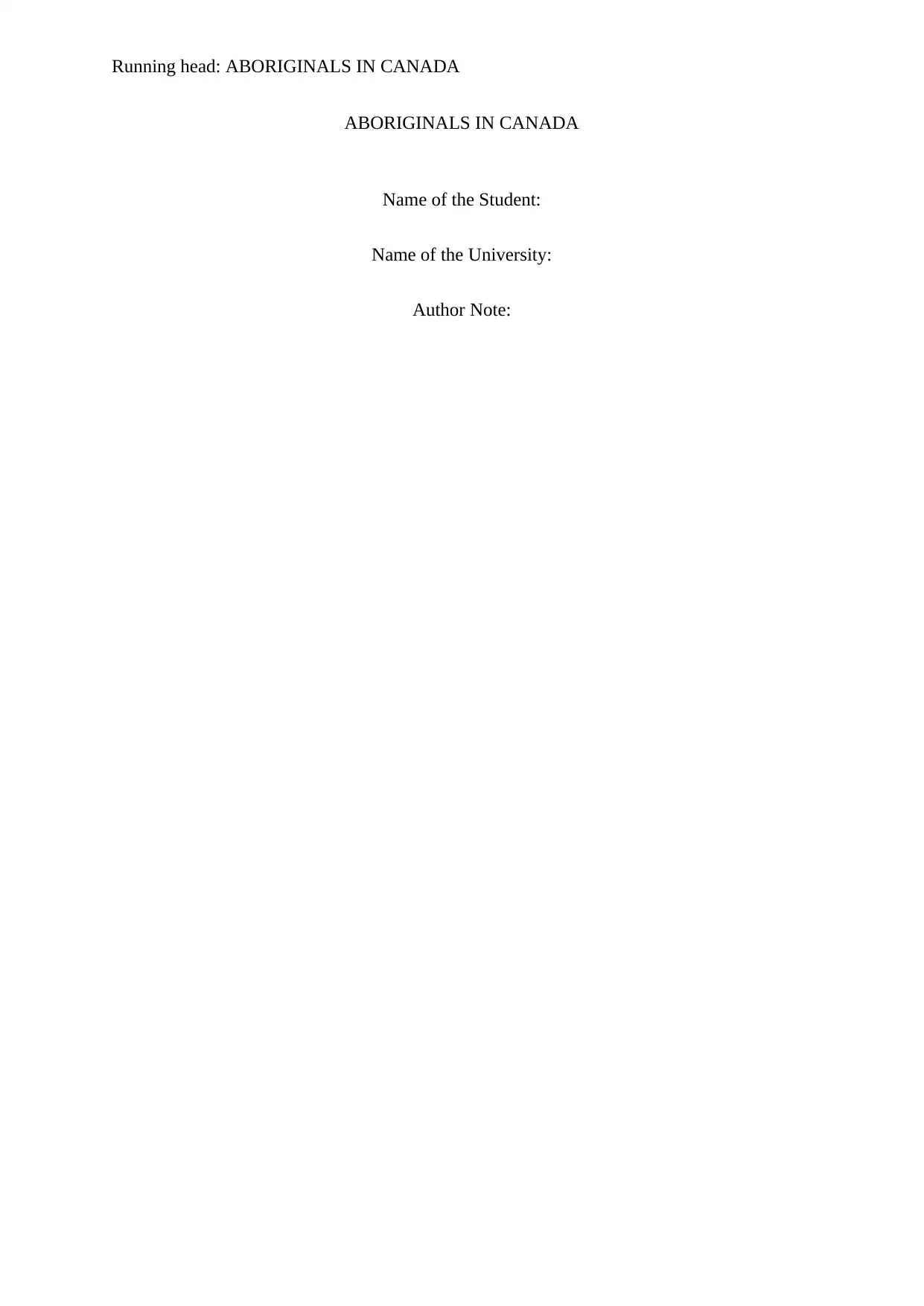
Running head: ABORIGINALS IN CANADA
ABORIGINALS IN CANADA
Name of the Student:
Name of the University:
Author Note:
ABORIGINALS IN CANADA
Name of the Student:
Name of the University:
Author Note:
Paraphrase This Document
Need a fresh take? Get an instant paraphrase of this document with our AI Paraphraser
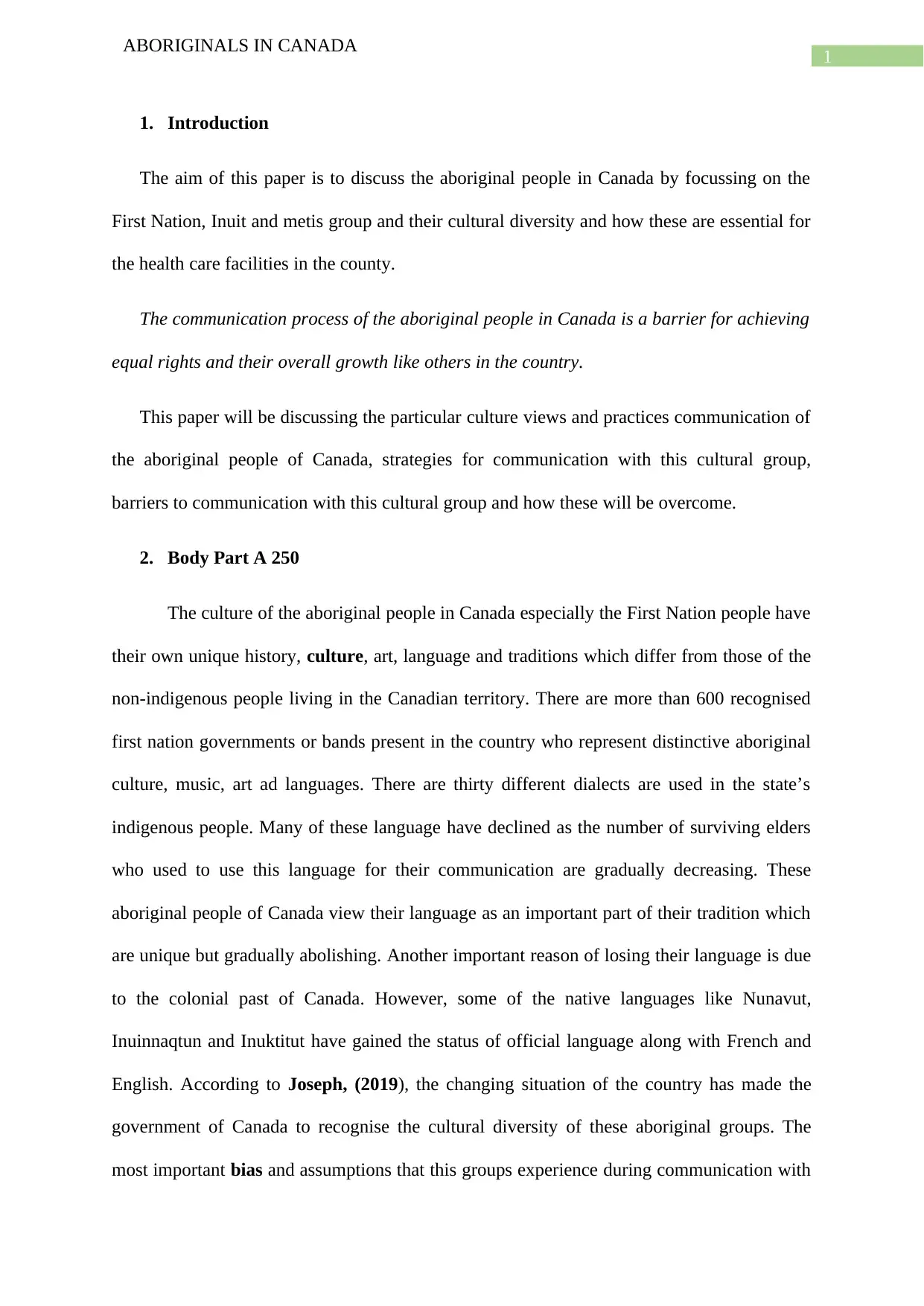
1
ABORIGINALS IN CANADA
1. Introduction
The aim of this paper is to discuss the aboriginal people in Canada by focussing on the
First Nation, Inuit and metis group and their cultural diversity and how these are essential for
the health care facilities in the county.
The communication process of the aboriginal people in Canada is a barrier for achieving
equal rights and their overall growth like others in the country.
This paper will be discussing the particular culture views and practices communication of
the aboriginal people of Canada, strategies for communication with this cultural group,
barriers to communication with this cultural group and how these will be overcome.
2. Body Part A 250
The culture of the aboriginal people in Canada especially the First Nation people have
their own unique history, culture, art, language and traditions which differ from those of the
non-indigenous people living in the Canadian territory. There are more than 600 recognised
first nation governments or bands present in the country who represent distinctive aboriginal
culture, music, art ad languages. There are thirty different dialects are used in the state’s
indigenous people. Many of these language have declined as the number of surviving elders
who used to use this language for their communication are gradually decreasing. These
aboriginal people of Canada view their language as an important part of their tradition which
are unique but gradually abolishing. Another important reason of losing their language is due
to the colonial past of Canada. However, some of the native languages like Nunavut,
Inuinnaqtun and Inuktitut have gained the status of official language along with French and
English. According to Joseph, (2019), the changing situation of the country has made the
government of Canada to recognise the cultural diversity of these aboriginal groups. The
most important bias and assumptions that this groups experience during communication with
ABORIGINALS IN CANADA
1. Introduction
The aim of this paper is to discuss the aboriginal people in Canada by focussing on the
First Nation, Inuit and metis group and their cultural diversity and how these are essential for
the health care facilities in the county.
The communication process of the aboriginal people in Canada is a barrier for achieving
equal rights and their overall growth like others in the country.
This paper will be discussing the particular culture views and practices communication of
the aboriginal people of Canada, strategies for communication with this cultural group,
barriers to communication with this cultural group and how these will be overcome.
2. Body Part A 250
The culture of the aboriginal people in Canada especially the First Nation people have
their own unique history, culture, art, language and traditions which differ from those of the
non-indigenous people living in the Canadian territory. There are more than 600 recognised
first nation governments or bands present in the country who represent distinctive aboriginal
culture, music, art ad languages. There are thirty different dialects are used in the state’s
indigenous people. Many of these language have declined as the number of surviving elders
who used to use this language for their communication are gradually decreasing. These
aboriginal people of Canada view their language as an important part of their tradition which
are unique but gradually abolishing. Another important reason of losing their language is due
to the colonial past of Canada. However, some of the native languages like Nunavut,
Inuinnaqtun and Inuktitut have gained the status of official language along with French and
English. According to Joseph, (2019), the changing situation of the country has made the
government of Canada to recognise the cultural diversity of these aboriginal groups. The
most important bias and assumptions that this groups experience during communication with
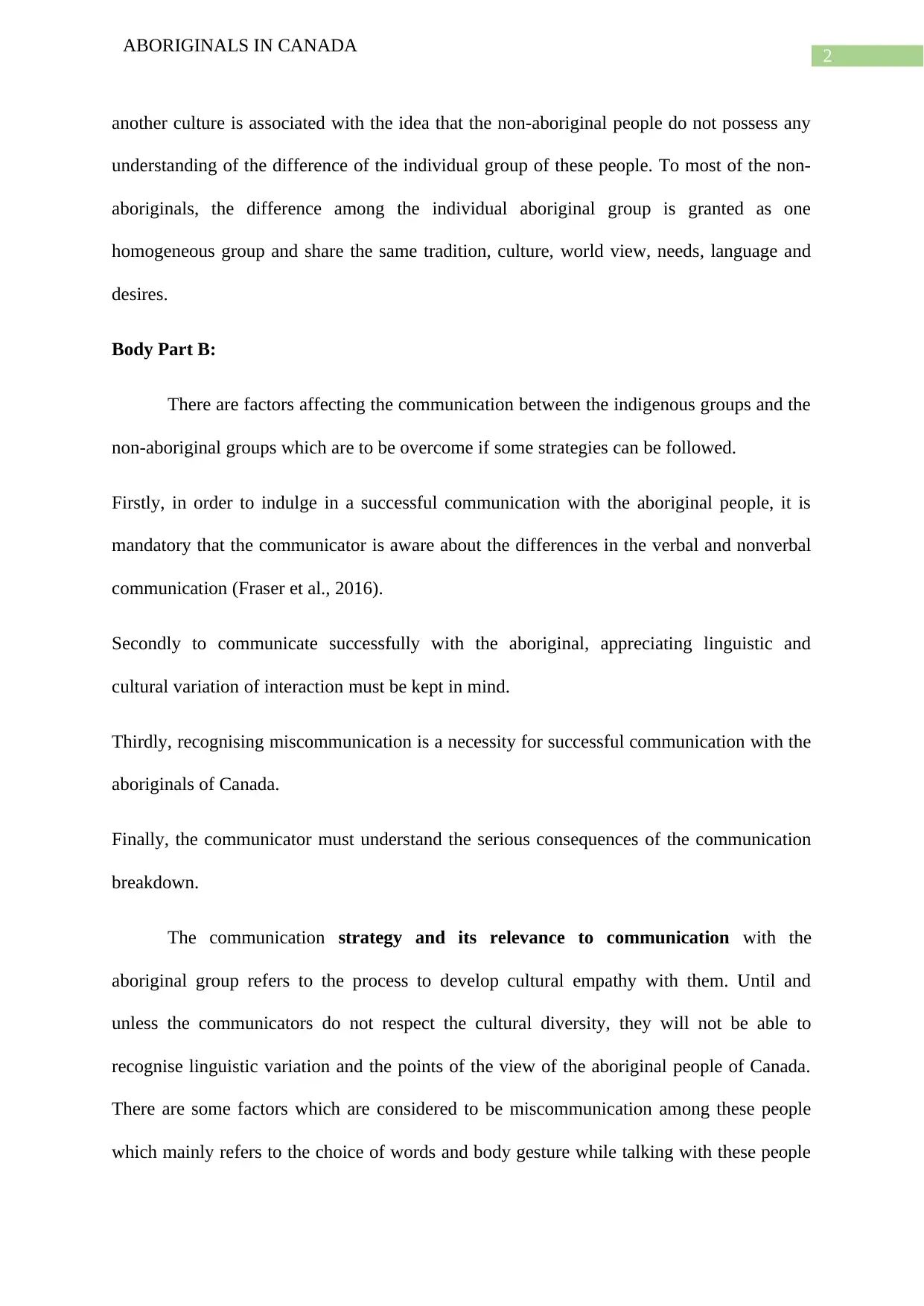
2
ABORIGINALS IN CANADA
another culture is associated with the idea that the non-aboriginal people do not possess any
understanding of the difference of the individual group of these people. To most of the non-
aboriginals, the difference among the individual aboriginal group is granted as one
homogeneous group and share the same tradition, culture, world view, needs, language and
desires.
Body Part B:
There are factors affecting the communication between the indigenous groups and the
non-aboriginal groups which are to be overcome if some strategies can be followed.
Firstly, in order to indulge in a successful communication with the aboriginal people, it is
mandatory that the communicator is aware about the differences in the verbal and nonverbal
communication (Fraser et al., 2016).
Secondly to communicate successfully with the aboriginal, appreciating linguistic and
cultural variation of interaction must be kept in mind.
Thirdly, recognising miscommunication is a necessity for successful communication with the
aboriginals of Canada.
Finally, the communicator must understand the serious consequences of the communication
breakdown.
The communication strategy and its relevance to communication with the
aboriginal group refers to the process to develop cultural empathy with them. Until and
unless the communicators do not respect the cultural diversity, they will not be able to
recognise linguistic variation and the points of the view of the aboriginal people of Canada.
There are some factors which are considered to be miscommunication among these people
which mainly refers to the choice of words and body gesture while talking with these people
ABORIGINALS IN CANADA
another culture is associated with the idea that the non-aboriginal people do not possess any
understanding of the difference of the individual group of these people. To most of the non-
aboriginals, the difference among the individual aboriginal group is granted as one
homogeneous group and share the same tradition, culture, world view, needs, language and
desires.
Body Part B:
There are factors affecting the communication between the indigenous groups and the
non-aboriginal groups which are to be overcome if some strategies can be followed.
Firstly, in order to indulge in a successful communication with the aboriginal people, it is
mandatory that the communicator is aware about the differences in the verbal and nonverbal
communication (Fraser et al., 2016).
Secondly to communicate successfully with the aboriginal, appreciating linguistic and
cultural variation of interaction must be kept in mind.
Thirdly, recognising miscommunication is a necessity for successful communication with the
aboriginals of Canada.
Finally, the communicator must understand the serious consequences of the communication
breakdown.
The communication strategy and its relevance to communication with the
aboriginal group refers to the process to develop cultural empathy with them. Until and
unless the communicators do not respect the cultural diversity, they will not be able to
recognise linguistic variation and the points of the view of the aboriginal people of Canada.
There are some factors which are considered to be miscommunication among these people
which mainly refers to the choice of words and body gesture while talking with these people
⊘ This is a preview!⊘
Do you want full access?
Subscribe today to unlock all pages.

Trusted by 1+ million students worldwide
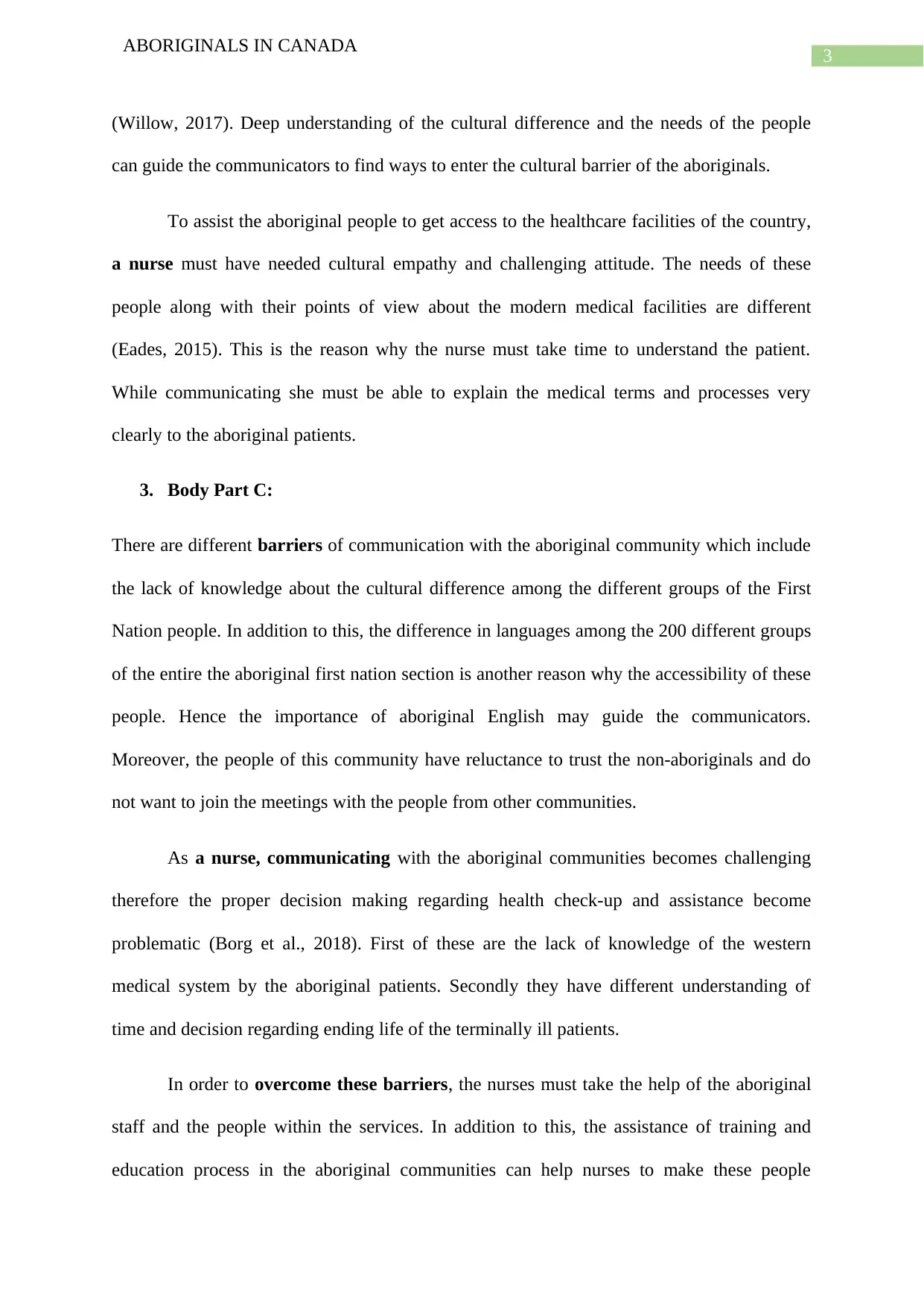
3
ABORIGINALS IN CANADA
(Willow, 2017). Deep understanding of the cultural difference and the needs of the people
can guide the communicators to find ways to enter the cultural barrier of the aboriginals.
To assist the aboriginal people to get access to the healthcare facilities of the country,
a nurse must have needed cultural empathy and challenging attitude. The needs of these
people along with their points of view about the modern medical facilities are different
(Eades, 2015). This is the reason why the nurse must take time to understand the patient.
While communicating she must be able to explain the medical terms and processes very
clearly to the aboriginal patients.
3. Body Part C:
There are different barriers of communication with the aboriginal community which include
the lack of knowledge about the cultural difference among the different groups of the First
Nation people. In addition to this, the difference in languages among the 200 different groups
of the entire the aboriginal first nation section is another reason why the accessibility of these
people. Hence the importance of aboriginal English may guide the communicators.
Moreover, the people of this community have reluctance to trust the non-aboriginals and do
not want to join the meetings with the people from other communities.
As a nurse, communicating with the aboriginal communities becomes challenging
therefore the proper decision making regarding health check-up and assistance become
problematic (Borg et al., 2018). First of these are the lack of knowledge of the western
medical system by the aboriginal patients. Secondly they have different understanding of
time and decision regarding ending life of the terminally ill patients.
In order to overcome these barriers, the nurses must take the help of the aboriginal
staff and the people within the services. In addition to this, the assistance of training and
education process in the aboriginal communities can help nurses to make these people
ABORIGINALS IN CANADA
(Willow, 2017). Deep understanding of the cultural difference and the needs of the people
can guide the communicators to find ways to enter the cultural barrier of the aboriginals.
To assist the aboriginal people to get access to the healthcare facilities of the country,
a nurse must have needed cultural empathy and challenging attitude. The needs of these
people along with their points of view about the modern medical facilities are different
(Eades, 2015). This is the reason why the nurse must take time to understand the patient.
While communicating she must be able to explain the medical terms and processes very
clearly to the aboriginal patients.
3. Body Part C:
There are different barriers of communication with the aboriginal community which include
the lack of knowledge about the cultural difference among the different groups of the First
Nation people. In addition to this, the difference in languages among the 200 different groups
of the entire the aboriginal first nation section is another reason why the accessibility of these
people. Hence the importance of aboriginal English may guide the communicators.
Moreover, the people of this community have reluctance to trust the non-aboriginals and do
not want to join the meetings with the people from other communities.
As a nurse, communicating with the aboriginal communities becomes challenging
therefore the proper decision making regarding health check-up and assistance become
problematic (Borg et al., 2018). First of these are the lack of knowledge of the western
medical system by the aboriginal patients. Secondly they have different understanding of
time and decision regarding ending life of the terminally ill patients.
In order to overcome these barriers, the nurses must take the help of the aboriginal
staff and the people within the services. In addition to this, the assistance of training and
education process in the aboriginal communities can help nurses to make these people
Paraphrase This Document
Need a fresh take? Get an instant paraphrase of this document with our AI Paraphraser
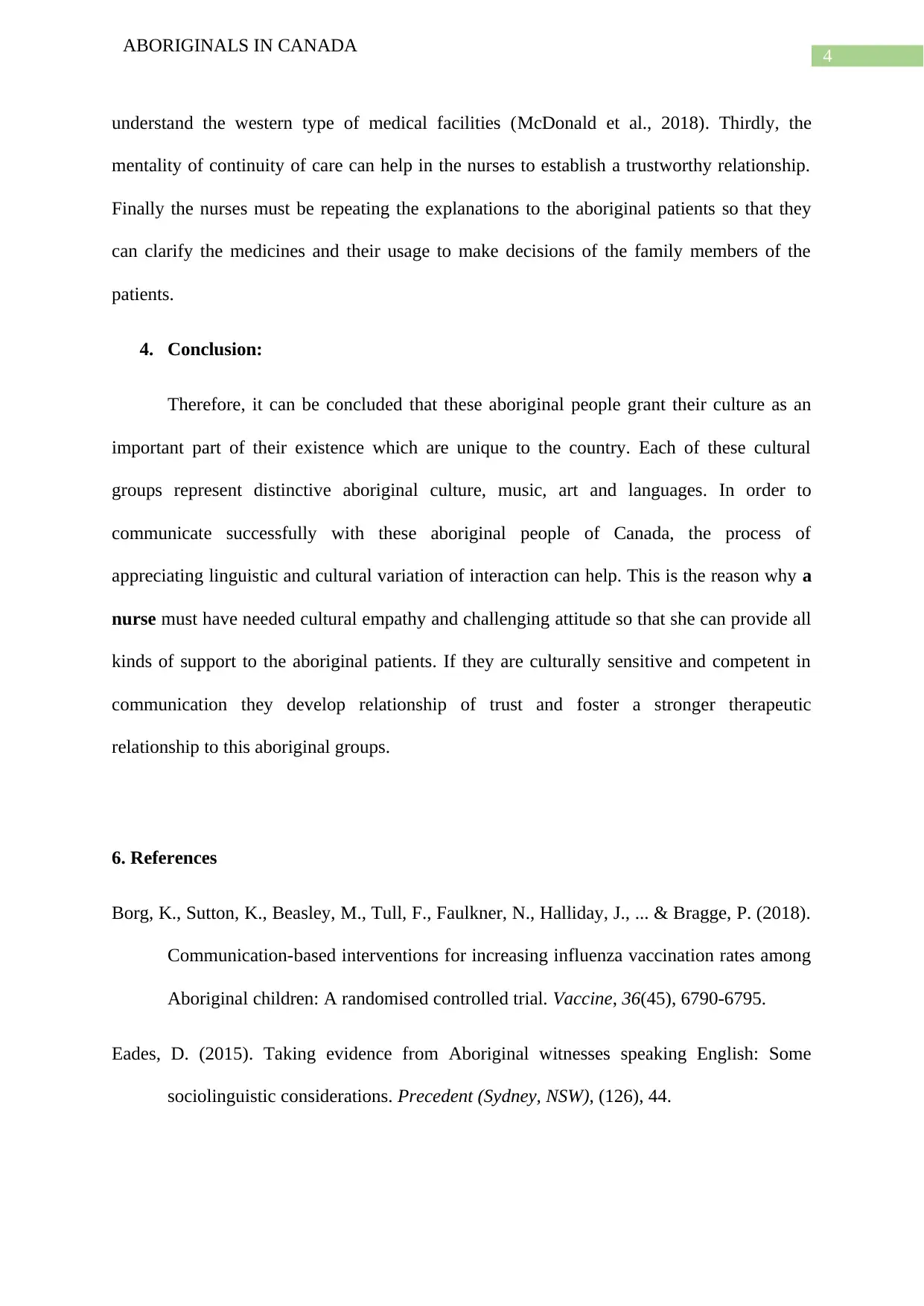
4
ABORIGINALS IN CANADA
understand the western type of medical facilities (McDonald et al., 2018). Thirdly, the
mentality of continuity of care can help in the nurses to establish a trustworthy relationship.
Finally the nurses must be repeating the explanations to the aboriginal patients so that they
can clarify the medicines and their usage to make decisions of the family members of the
patients.
4. Conclusion:
Therefore, it can be concluded that these aboriginal people grant their culture as an
important part of their existence which are unique to the country. Each of these cultural
groups represent distinctive aboriginal culture, music, art and languages. In order to
communicate successfully with these aboriginal people of Canada, the process of
appreciating linguistic and cultural variation of interaction can help. This is the reason why a
nurse must have needed cultural empathy and challenging attitude so that she can provide all
kinds of support to the aboriginal patients. If they are culturally sensitive and competent in
communication they develop relationship of trust and foster a stronger therapeutic
relationship to this aboriginal groups.
6. References
Borg, K., Sutton, K., Beasley, M., Tull, F., Faulkner, N., Halliday, J., ... & Bragge, P. (2018).
Communication-based interventions for increasing influenza vaccination rates among
Aboriginal children: A randomised controlled trial. Vaccine, 36(45), 6790-6795.
Eades, D. (2015). Taking evidence from Aboriginal witnesses speaking English: Some
sociolinguistic considerations. Precedent (Sydney, NSW), (126), 44.
ABORIGINALS IN CANADA
understand the western type of medical facilities (McDonald et al., 2018). Thirdly, the
mentality of continuity of care can help in the nurses to establish a trustworthy relationship.
Finally the nurses must be repeating the explanations to the aboriginal patients so that they
can clarify the medicines and their usage to make decisions of the family members of the
patients.
4. Conclusion:
Therefore, it can be concluded that these aboriginal people grant their culture as an
important part of their existence which are unique to the country. Each of these cultural
groups represent distinctive aboriginal culture, music, art and languages. In order to
communicate successfully with these aboriginal people of Canada, the process of
appreciating linguistic and cultural variation of interaction can help. This is the reason why a
nurse must have needed cultural empathy and challenging attitude so that she can provide all
kinds of support to the aboriginal patients. If they are culturally sensitive and competent in
communication they develop relationship of trust and foster a stronger therapeutic
relationship to this aboriginal groups.
6. References
Borg, K., Sutton, K., Beasley, M., Tull, F., Faulkner, N., Halliday, J., ... & Bragge, P. (2018).
Communication-based interventions for increasing influenza vaccination rates among
Aboriginal children: A randomised controlled trial. Vaccine, 36(45), 6790-6795.
Eades, D. (2015). Taking evidence from Aboriginal witnesses speaking English: Some
sociolinguistic considerations. Precedent (Sydney, NSW), (126), 44.
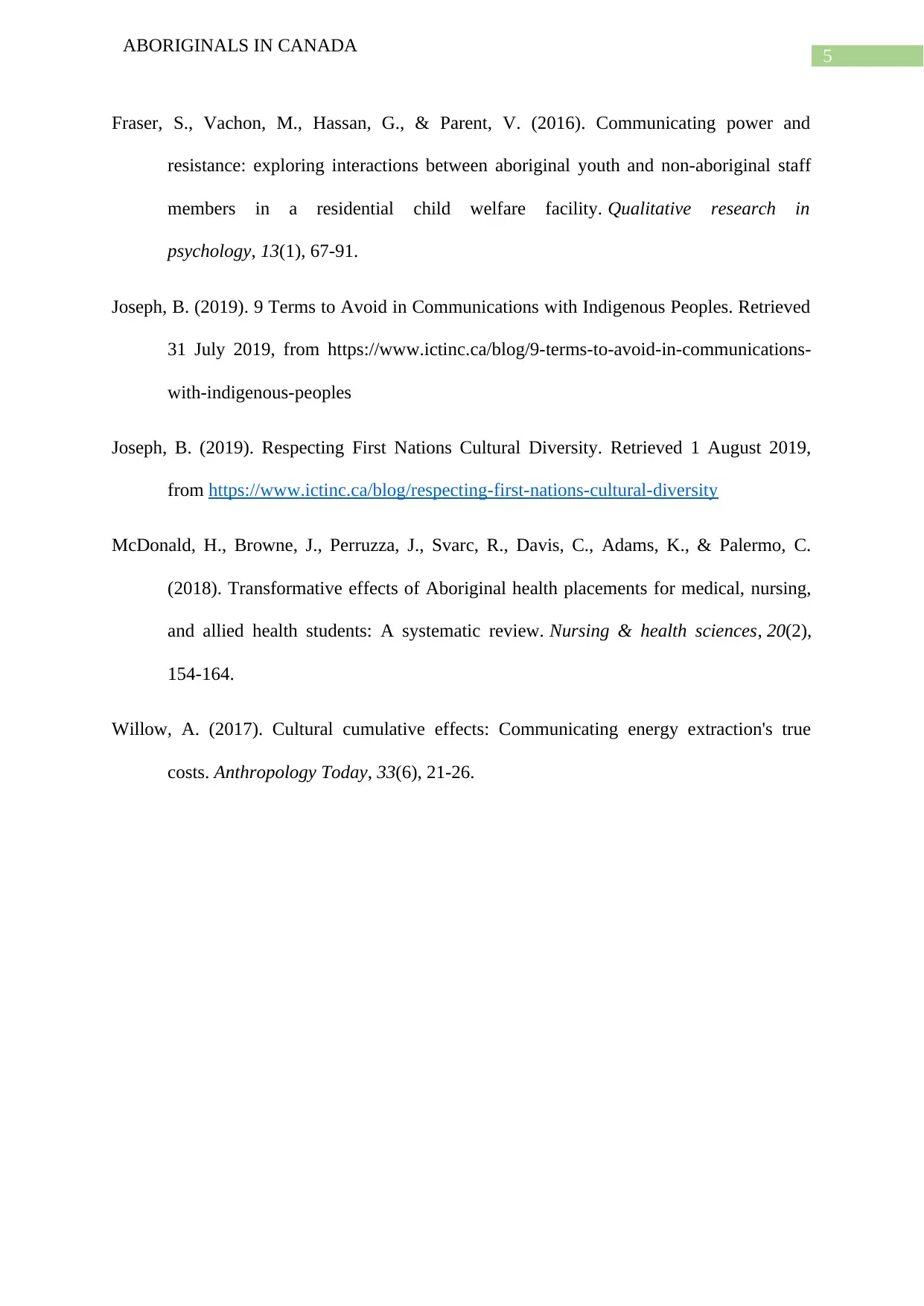
5
ABORIGINALS IN CANADA
Fraser, S., Vachon, M., Hassan, G., & Parent, V. (2016). Communicating power and
resistance: exploring interactions between aboriginal youth and non-aboriginal staff
members in a residential child welfare facility. Qualitative research in
psychology, 13(1), 67-91.
Joseph, B. (2019). 9 Terms to Avoid in Communications with Indigenous Peoples. Retrieved
31 July 2019, from https://www.ictinc.ca/blog/9-terms-to-avoid-in-communications-
with-indigenous-peoples
Joseph, B. (2019). Respecting First Nations Cultural Diversity. Retrieved 1 August 2019,
from https://www.ictinc.ca/blog/respecting-first-nations-cultural-diversity
McDonald, H., Browne, J., Perruzza, J., Svarc, R., Davis, C., Adams, K., & Palermo, C.
(2018). Transformative effects of Aboriginal health placements for medical, nursing,
and allied health students: A systematic review. Nursing & health sciences, 20(2),
154-164.
Willow, A. (2017). Cultural cumulative effects: Communicating energy extraction's true
costs. Anthropology Today, 33(6), 21-26.
ABORIGINALS IN CANADA
Fraser, S., Vachon, M., Hassan, G., & Parent, V. (2016). Communicating power and
resistance: exploring interactions between aboriginal youth and non-aboriginal staff
members in a residential child welfare facility. Qualitative research in
psychology, 13(1), 67-91.
Joseph, B. (2019). 9 Terms to Avoid in Communications with Indigenous Peoples. Retrieved
31 July 2019, from https://www.ictinc.ca/blog/9-terms-to-avoid-in-communications-
with-indigenous-peoples
Joseph, B. (2019). Respecting First Nations Cultural Diversity. Retrieved 1 August 2019,
from https://www.ictinc.ca/blog/respecting-first-nations-cultural-diversity
McDonald, H., Browne, J., Perruzza, J., Svarc, R., Davis, C., Adams, K., & Palermo, C.
(2018). Transformative effects of Aboriginal health placements for medical, nursing,
and allied health students: A systematic review. Nursing & health sciences, 20(2),
154-164.
Willow, A. (2017). Cultural cumulative effects: Communicating energy extraction's true
costs. Anthropology Today, 33(6), 21-26.
⊘ This is a preview!⊘
Do you want full access?
Subscribe today to unlock all pages.

Trusted by 1+ million students worldwide
1 out of 6
Related Documents
Your All-in-One AI-Powered Toolkit for Academic Success.
+13062052269
info@desklib.com
Available 24*7 on WhatsApp / Email
![[object Object]](/_next/static/media/star-bottom.7253800d.svg)
Unlock your academic potential
Copyright © 2020–2025 A2Z Services. All Rights Reserved. Developed and managed by ZUCOL.





